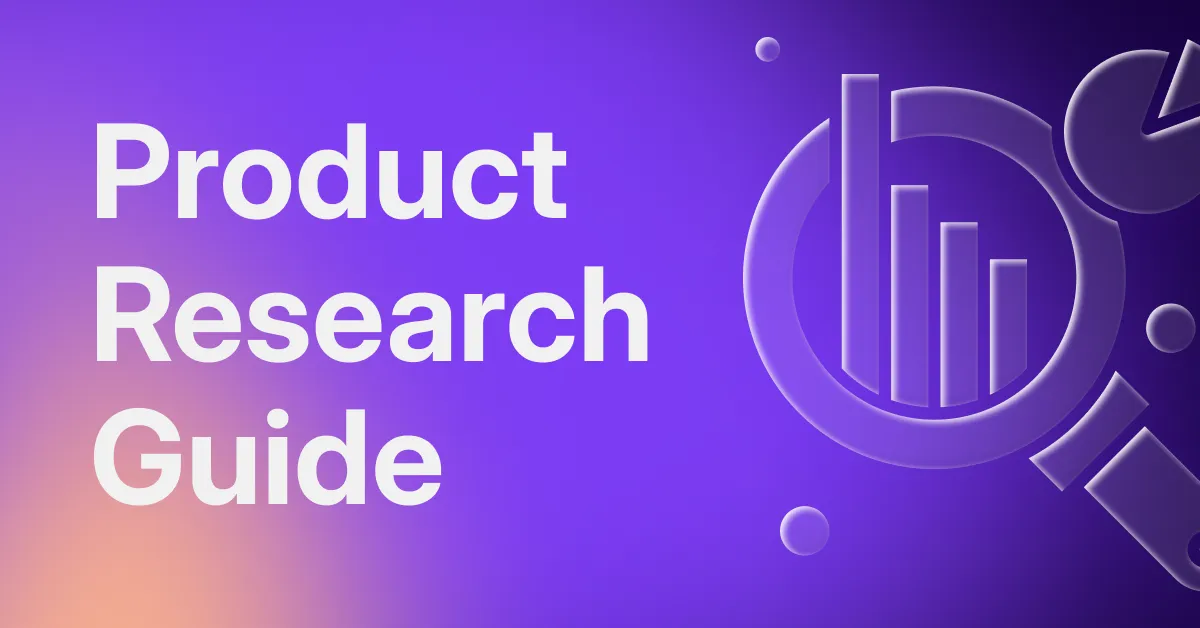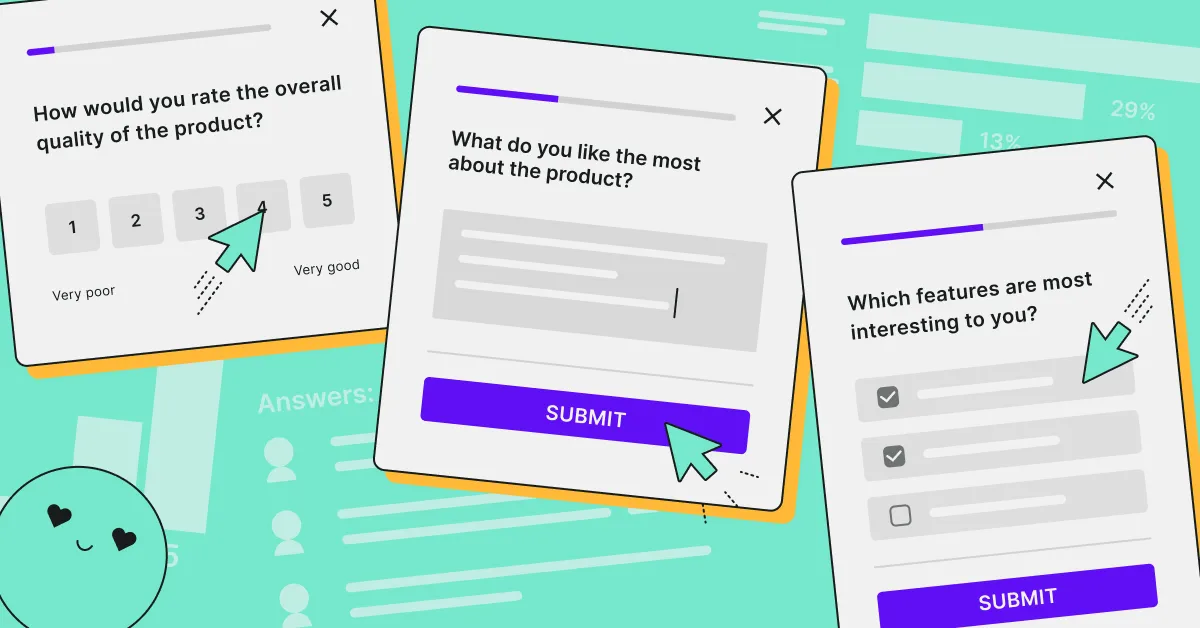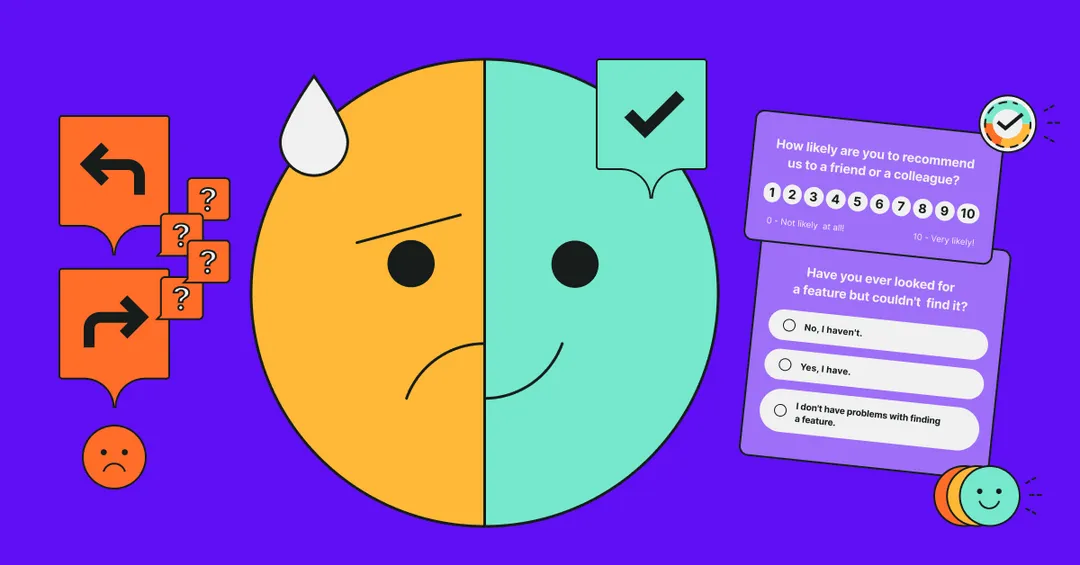Tl; dr;
- User-centric focus: The most critical aspect of a UX research process is its focus on the user. Every step, from planning to listening, must prioritize understanding and addressing user needs and behaviors to drive product success.
- Integration throughout development: User research should be a continuous thread throughout the product development lifecycle, not confined to a single phase, ensuring that user feedback informs every decision from concept to post-launch.
- Method selection matters: Choosing the right research methods is pivotal. Online surveys, for example, are invaluable for quickly gathering data from a broad audience, aiding in competitive analysis and identifying user trends.
- Actionable insights: The goal of UX research is to produce actionable insights. Data collected must be analyzed and translated into clear, practical design recommendations that can directly impact the product's usability and appeal.
- Adaptability and iteration: Flexibility is essential. Be prepared to adapt your research process in response to new insights, and iterate on your product based on continuous user feedback to refine and enhance the user experience.

Creating a structured UX research process ahead of starting the study will helo you ensure you consider all the necessary steps, from recruiting participants and collecting data to analyzing the findings and sharing the results.
However, designing an effective process can be daunting, given that it can make or break your UX research study.
So, where do you start? In this practical guide, we will demystify the UX research process and offer an actionable 7-step roadmap for you to follow.
If you plan to use surveys as part of your UX research, test out automated and expertly designed templates, such as the product features matrix survey:
Why do you need a strong UX research process?
Establishing a strong user research process is crucial for developing successful products that truly meet user needs. Without it, the risk of user dissatisfaction and business losses increases significantly.
To prevent user frustration
Avoiding guesswork: Basing design decisions on solid research rather than speculation ensures that user needs are accurately addressed.
Reducing errors: Systematic UX research helps in identifying potential issues early, reducing user frustration and error rates.
To drive business success
Enhancing conversion rates: Knowledge of user behavior and preferences informed by research translates into a design that encourages users to take desired actions.
Building customer loyalty: When users feel understood and their experiences are seamless, loyalty to your brand grows.
To minimize costs
Lowering churn rates: A product that meets user expectations is less likely to experience high dropout rates, which can be costly to reverse.
Preventing redesign expenses: Discovering design flaws after launch is often more expensive than investing in UX research during the development phase.
A strong UX research process is the base of user-centric design, where you ensure that your product is crafted with precision to cater to the target audience.
When should you conduct user research?
User research is not a one-time activity but a continuous process that should be integrated at various stages of product development process.
Before design begins: Conduct research to gather insights about your users' needs, behaviors, and pain points to inform the initial design.
During prototyping: Test concepts and prototypes with users to validate design decisions and iterate based on feedback.
Before finalizing the product: Perform usability testing to ensure the product is intuitive and meets user expectations.
After release: Continue to collect user feedback to identify areas for improvement and inform future updates.
Ongoing Research: Regularly schedule research activities to stay updated with changing user needs and market trends.
Timing your user research correctly is key to maximizing its impact. By embedding research throughout the product lifecycle, you can create a more user-friendly product, reduce the risk of costly redesigns, and maintain a competitive edge.
Most popular user research methods
When you start establishing an effective UX research process, first thing to do is selecting the right methods. Here are some of the most popular user research techniques that can provide valuable insights into user behavior and preferences.
Online surveys
Broad reach: They allow you to gather data from a large number of users quickly.
Quantifiable data: Surveys are excellent for collecting statistical data that can be easily analyzed.
User interviews
In-depth insights: One-on-one interviews offer a deep dive into individual user experiences and perspectives.
Flexibility: They can be structured or open-ended, providing flexibility in the type of information collected.
Usability testing
Real-world interaction: Observing users as they interact with your product highlights usability issues and areas for improvement.
Immediate feedback: Direct feedback from test participants can lead to quick iterations and enhancements.
Card sorting
Content organization: This method helps in understanding how users expect information to be organized and categorized.
Intuitive design: Insights from card sorting can inform the structure and navigation of your product.
A/B testing
Comparative analysis: By presenting two variations of a design, you can measure which one performs better in terms of user engagement.
Data-driven decisions: Decisions are made based on actual user behavior rather than assumptions.
Field studies
Contextual understanding: Observing users in their natural environment provides context to how they interact with your product in real life.
Rich qualitative data: Field studies yield nuanced information that can be missed in a controlled testing environment.
By incorporating these methods into your UX research process, you can gain a comprehensive understanding of your users and create a product that truly meets their needs.
4 phases of UX research process
The UX project process is a critical framework divided into four key phases, guiding teams from initial understanding to the refinement of user experiences.
Discovery Phase
Gather initial data: Collect existing data and insights to understand the baseline of user needs and business goals.
Stakeholder engagement: Align with stakeholders to define project scope and expectations.
User interviews: Conduct interviews to uncover user motivations, behaviors, and pain points.
Exploring Phase
Ideation Sessions: Brainstorm solutions to address user needs identified in the discovery phase.
Design Prototyping: Create low-fidelity prototypes to visualize potential solutions.
Feedback Loops: Engage with users and stakeholders to refine concepts and directions.
Testing Phase
Usability Testing: Conduct tests with higher-fidelity prototypes to observe user interactions and identify usability issues.
A/B Testing: Compare different design versions to determine which performs better in terms of user engagement and satisfaction.
Iterative Design: Refine designs based on testing feedback, ensuring continuous improvement.
Listening Phase
Post-launch analysis: After the product launch, monitor user feedback and behavior to gather actionable insights.
Surveys and interviews: Continue to collect qualitative data from users to understand their ongoing experience.
Data-driven iteration: Implement changes and enhancements based on user feedback and quantitative data.
By systematically moving through these phases, UX teams can create products that are not only functional and aesthetically pleasing but also deeply rooted in user needs and expectations.
7 steps to establish a UX research process at your organization
Step 1: Define your objectives
First and foremost in setting up a UX research process, you need to establish your objectives.
What do you hope to accomplish through your research? The answers might range from gaining a deeper understanding of user behavior, discovering areas of friction within your product, or verifying the effectiveness of a new feature.
Your objectives should serve as the foundation for your research design, guiding your methodology, and keeping your research efforts focused and valuable.
Importantly, these objectives need to be precise, measurable, and in sync with your overarching business goals. Above all, they need to be user-centric, putting the spotlight on users' needs, behaviors, and pain points.
At this stage, it's crucial to involve key stakeholders to ensure shared understanding and agreement on the research goals.
Step 2: Choose your research tools and methods
There are many UX research methods, each with its unique strengths and weaknesses. The one you choose should align with your objectives, the resources you have at your disposal, and the constraints of your project timeline.
Qualitative methods like in-depth interviews, focus groups, and ethnographic studies offer rich, granular insights into user attitudes, behaviors, and motivations.
On the other hand, quantitative methods such as online surveys, analytics tracking, and A/B testing provide statistically significant data, revealing overarching user trends and preferences.
For the most robust and comprehensive insights, many researchers opt for a multi-method strategy known as triangulation.
This approach provides a more holistic view of your research question, enabling you to validate and enrich your findings by examining the question from different perspectives.
When picking the right research method, you might want to consider the following factors:
- Project stage: If your research project is in an early stage, exploratory research methods, such as interviews and focus groups, might work best. Later on, validation research (including usability testing and A/B testing) might be more appropriate.
- Research objectives: Arguably the most crucial consideration is what you hope to accomplish with your study.
- Time and resources: Some methods are more time and resource-intensive than others. For instance, surveys offer a quick and cost-effective means of gathering data. If you’re looking to conduct usability tests or field studies, this is likely to require more resources and preparation.
- Type of data needed: You might need qualitative or quantitative data, or a combination of both.
As one of the most popular and cost-effective UX research methods, surveys are particularly useful when you need to gather data from a large and diverse population.
With survey tools such as Survicate, you can automate the process and gather unlimited user insights:
Step 3: Develop a research plan
A UX research plan outlines the specifics of how you'll carry out your research. It should detail the objectives, methodology, participants, schedule, and expected outcomes.
Your research plan serves as a roadmap, detailing the why, what, when, where, who, and how of the research project.
There are plenty of benefits to creating a plan before you start your research, including:
- setting clear goals,
- facilitating more efficient resource management,
- improving communication within the team
- reducing risks by identifying obstacles at an early stage,
- improving record-keeping for future reference.
Your UX research plan should include details on the following elements:
- timeline,
- necessary resources,
- tools and methods,
- recruitment of participants,
- data analysis and presentation,
- foreseen impact on the product’s design.
Step 4: Recruit participants
Once your research plan is in place, you can start recruiting participants. The number and type of participants depend on your methodology and research questions.
For qualitative research, you can often get rich insights from a relatively small number of participants. For quantitative research, you'll need a larger sample to achieve statistical significance.
First, clearly define who your users are. Use demographic and psychographic information, along with product usage data, to pinpoint the characteristics of the ideal participant.
Then, create user personas to further clarify the types of users you want to target. These are fictional representations of your users, and they help to visualize the different user types that might use your product.
Offering incentives is a common practice to encourage users to participate in the research. This could be in the form of monetary rewards, gift cards, product discounts, or other forms of compensation.
Be transparent with potential participants about what the study involves, the expected time commitment, how their data will be used, and their rights in the research process.
Surveys such as the one below can help you in the process of screening and recruiting UX research participants:
Step 5: Conduct the research
This is where the actual data collection happens. The most critical part here is to remain objective and unbiased as you gather data.
Avoid leading questions and let the participants speak freely. Record your sessions whenever possible (with the participant's consent) to ensure accuracy in your notes.
In this phase, it's essential to be flexible and adaptable. If an interview reveals new information that warrants further investigation, be ready to modify your research plan.
Step 6: Analyze and interpret the data
Once you've collected the data, it's time to analyze and interpret the findings. This involves understanding its implications—it’s not just about what the data says but what it means for your users and your product.
Depending on the methods you used, you may have data in various forms: notes, audio recordings, video footage, survey responses, etc.
Transcribe all the necessary data into a format that's easy to analyze, like a spreadsheet or a qualitative data analysis tool.
When analyzing quantitative data, you might need to use statistical analysis to identify trends, correlations, or significant differences.
For qualitative data, this could involve more interpretive analysis to understand user attitudes, feelings, and behaviors.
When poring over your data, look for common themes or patterns as they can form the basis for further analysis.
Interpret your findings in the context of your research questions and objectives you set at the start of the study. What do your findings mean for your product, and how do they help answer your questions?
To make the data easier to understand and communicate to others, create visual representations of your findings, such as graphs, charts, or infographics.
Step 7: Present the findings
The goal of this part of the process is to convey the value and insights from your UX research in a way that's compelling and actionable to the stakeholders.
Storytelling is a powerful way to share your findings. Use your data to tell a story about the user's journey, their pain points, and how your recommendations could improve their experience.
Start with an executive summary that provides a quick overview of the research, including its purpose, the methods used, the main findings, and the key recommendations.
Translate your findings into practical, actionable recommendations, making sure these are clearly tied to the findings, and explain how they will benefit the product or service.
At the same time, point out any limitations that might affect the interpretation of your results. This could be things like sample size, research methodology, or other constraints.
Collect user insights with surveys
Establishing a systematic UX research process is fundamental to creating products that truly resonate with users. This step-by-step guide provides you with a robust framework to understand your users deeply, optimize resource allocation, ensure consistency, control quality, and inform design decisions.
Remember, a well-defined UX research process isn't just a protocol—it's a strategic approach to uncovering user needs, behaviors, and preferences. It not only leads to actionable insights but also helps in creating a product that is genuinely user-centric.
You most likely included surveys as part of your UX research process. The easiest way to send surveys is by using an automated tool such as Survicate. Not only you’ll get access to AI survey creator, that will create your surveys in a blink of an eye, but you’ll also be able to track and analyze the results in real time. Sign up today and start collecting user insights.













.webp)
.webp)
.svg)

.svg)



